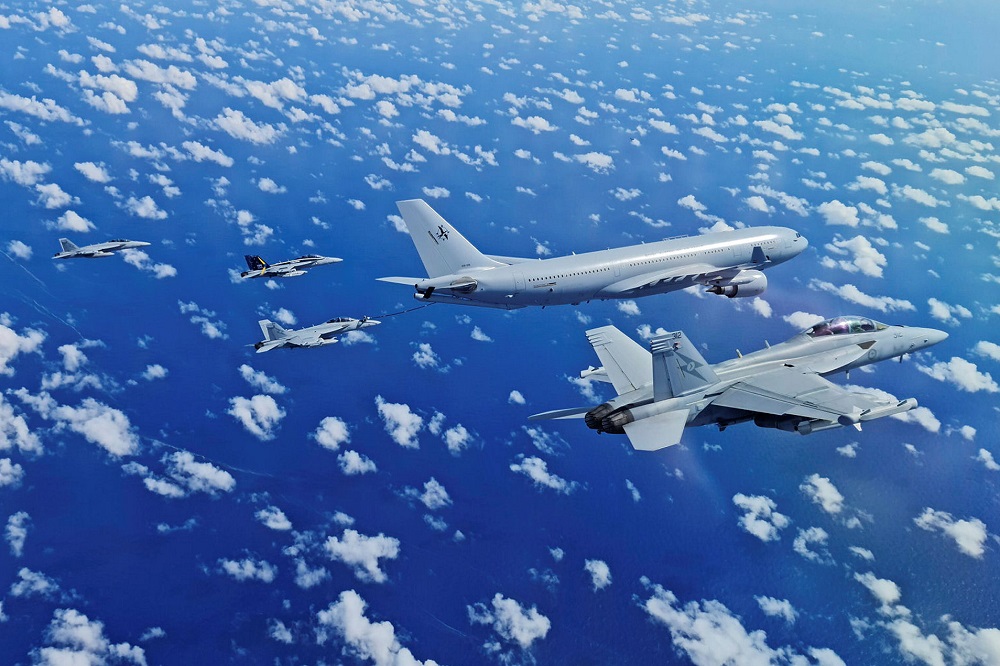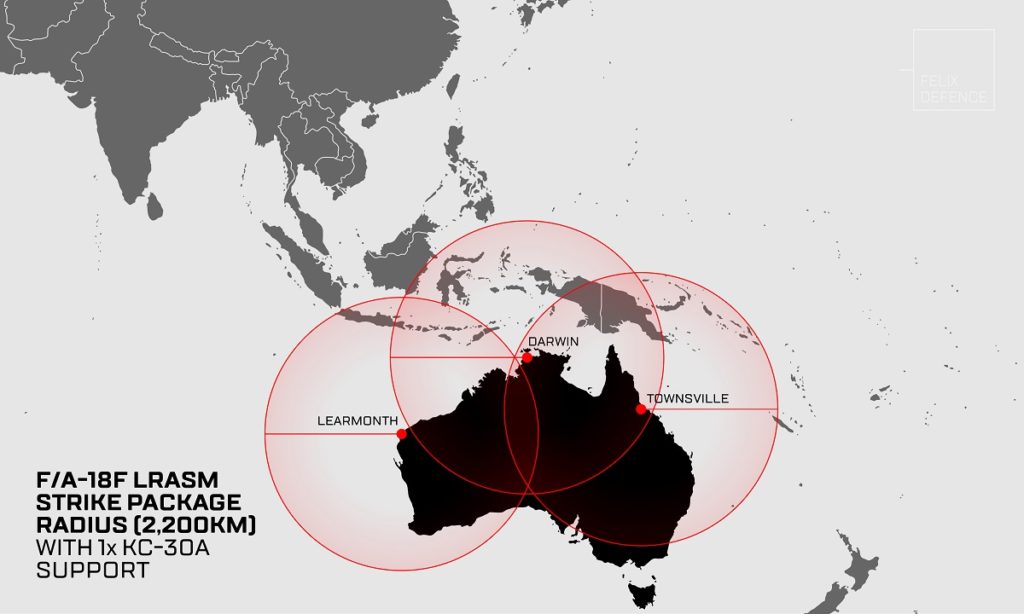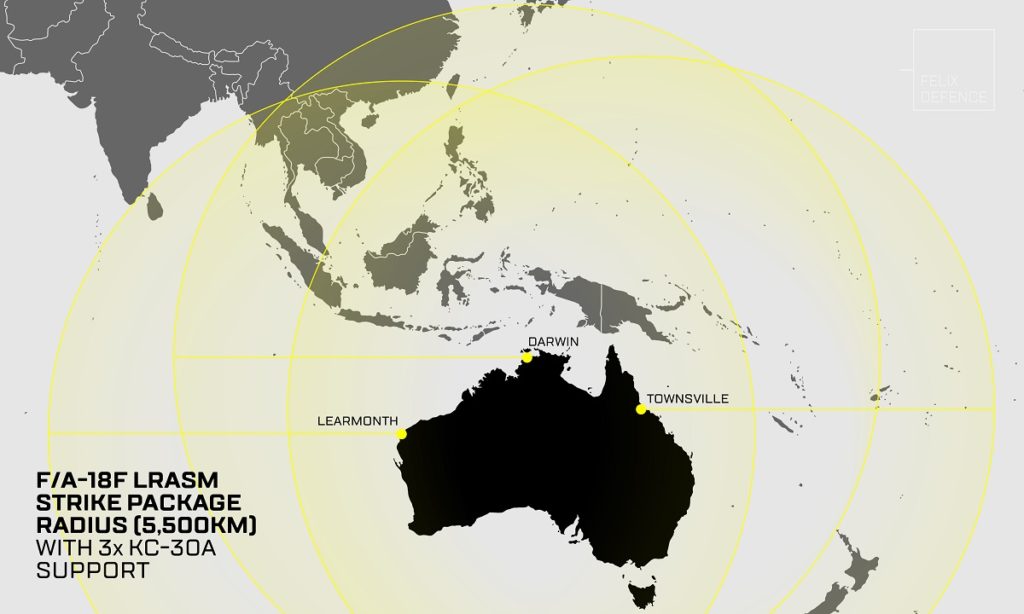By Dougal Robertson and Chris McInnes
If the Defence Minister wants “greater projection, greater lethality, [and] greater ability to engage in area denial” the fastest way to get there is expand the RAAF’s strike capabilities. The reason is simple: the RAAF’s aircraft and weapons have better range and responsiveness and are available much sooner than any proposed alternatives. We just need more of them.
The RAAF will have two important long-range anti-shipping and land attack weapons in the inventory by 2025. They are the 500km-plus Long-Range Anti-Shipping Missile (LRASM) and the 900km plus Joint Air to Surface Standoff Missile – Extended Range (JASSM-ER), both carrying 450kg warheads ideal for large targets. The RAAF’s F/A-18F Super Hornets will initially carry these weapons and, depending on loadout and aerial refuelling support, can fly at least 1,500km (and return). This means a weapon effectiveness radius of at least 2,000km against ships and nearly 2,500km for land strike.
A RAAF ‘strike package’ taking off from Darwin can reach the southern Philippines, the Java Sea and the Bismarck Sea. From Townsville, the seas around the Solomon Islands are covered, including all the Coral Sea. Aircraft operating from Learmonth, near Exmouth in Western Australia, could strike ships trying to break through chokepoints at the Sunda Strait (west of Java) and the Lombok Strait (east of Bali). It would take less than three hours from aircraft launch for weapons to impact their targets.
Aircraft can then relocate from base to base, hitting land or maritime targets across an area larger than the entire European continent (10.1 million square kilometres). Versatile platforms like the Super Hornet can fly multiple mission types, so RAAF strike forces could locate and destroy land targets to Australia’s east on Tuesday, enemy shipping in the Sunda Strait on Wednesday, then mount an airborne defence of Darwin on Thursday.
These missions would all be launched from mainland Australia – meaning no need for potentially provocative pre-positioning, negotiating base permissions with regional partners, or defending deployed forces and supply lines. If forward bases are available, the RAAF’s reach gets longer.
Constrained capacity
But the RAAF’s strike capacity is constrained. Australia’s F-35A has a range over 2,200km, 30 per cent more than Super Hornet, but isn’t yet approved to carry the JASSM-ER or LRASM. The RAAF’s 15 P-8A Poseidon long-range maritime patrol aircraft won’t be LRASM capable until the first airframes are upgraded to ‘Increment Three’ from 2024 onwards. That creates a heavy reliance on the Super Hornet to conduct strike missions in defence of Australia.
The 24-strong Super Hornet fleet is overworked, tasked with operations and training. Using the standard 80 per cent availability metric with aircraft cycling through maintenance, 12 to 14 airframes would be available at short notice assuming six jets are reserved for training. To ensure concurrent operations on the Australian continent only half that number would likely be moved forward for a strike mission
And what of the missiles themselves? In 2020 the United States approved the sale of up to 200 LRASMs to Australia. The actual number of missiles procured is likely to be much less, given the publicly stated total figure for the deal from Defence (A$800m) is significantly less than the estimated total value of the US Foreign Military Sale contract (A$1.4bn).
The RAAF has 80 JASSM Extended Range (JASSM-ER) on order which will be fitted to the Super Hornet from 2024 and later to the F-35A when integration testing is finished. Work is underway to fit LRASM to the F-35A. Australia is also cooperating with the Norwegian-led Joint Strike Missile (JSM) program to fit the JSM to the F-35A in a similar timeframe. The 200 to 500km JSM will be carried internally to preserve the F-35A’s stealthy shape.
Building now for the future
If the Government wants more range and lethality for the ADF in the next five to seven years, boosting the RAAF’s strike forces is the fastest and farthest-reaching option. To exploit this opportunity the Government should put the following building blocks into position.
First, extend the persistence and reach of launch aircraft by doubling the RAAF KC-30A Multi-Role Tanker Transport fleet to 14 aircraft. A 14-tanker fleet means the RAAF could have 3-4 tankers in position for operations in the north, centre and east of Australia simultaneously. More tankers allow strike forces to reach farther and stay in the fight for longer at lower risk, bouncing on and off the tanker ‘treadmill’ to overcome the region’s vast distances.
A single KC-30A fuel offload of 120,000 lbs means it can ‘top-up’ an individual Super Hornet with 7,000lbs of fuel (half the Hornet’s internal fuel capacity) 17 times. This means a mixed 10-aircraft strike package supported by three tankers could engage shipping up to 5,500km from Australia, and land targets up to 6,000km away. A fleet of 14 KC-30A could support strike operations from three locations while retaining 2-3 airframes for personnel transport (300 troops), aeromedical evacuation (130 stretchers) or cargo (eight standard 463L pallets weighing up to 4,500kg) and coalition support.
Second, acquire more launch assets. There are three elements to this: expedite the approval and software upgrades for LRASM carriage on the RAAF’s P-8A; buy additional P-8A airframes to hunt submarines and carry LRASM to the fight; and expand the fighter fleet to deploy over a hundred LRASM and JASSM-ER launchers.
Third, increase Australia’s munitions holdings and options. The Government should buy more weapons, contribute funding to integrate JASSM-ER and LRASM onto the F-35A and continue the JSM program. These long-range weapons should be among the highest priorities for local production through Australia’s Sovereign Guided Weapons and Explosive Ordnance manufacturing capability.
The Government can best give the ADF greater projection, greater lethality, [and] greater ability to engage in area denial in the next five to seven years by adding capacity to the RAAF’s strike forces. These proven and versatile capabilities offer superior range and responsiveness, are interchangeable with the United States, and in service sooner than any alternative. A rapid expansion of the RAAF’s strike capacity buys Australia time to mature other options including hypersonic missiles, autonomous systems and nuclear submarines. The RAAF’s long-range fires are ready for take-off – we just need more of them.



